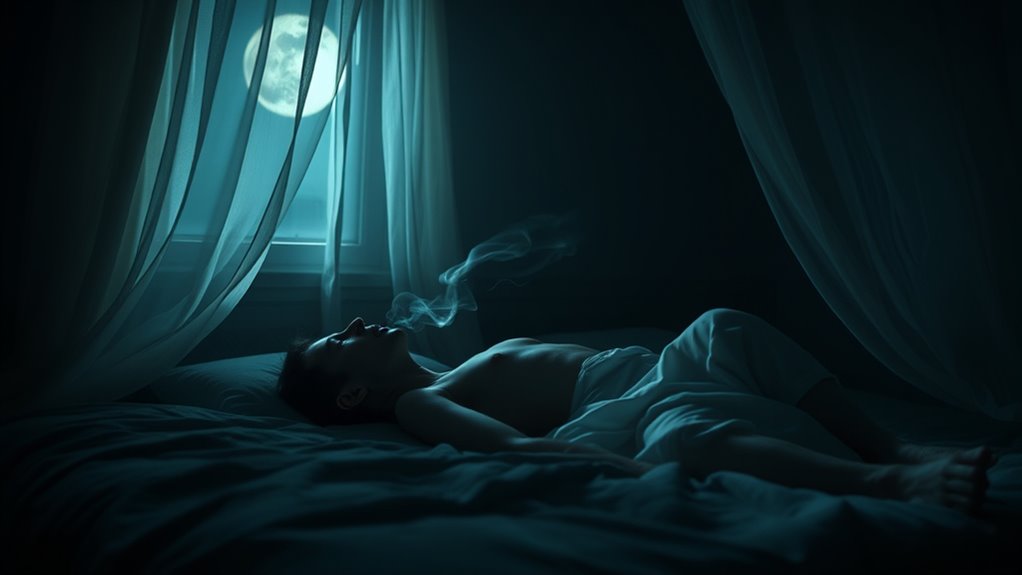To safely shift from sleep paralysis to lucidity, stay calm and recognize the experience as natural. Focus on calming your mind and breathing deeply to ease any fear. Practice good sleep hygiene by maintaining regular sleep schedules and avoiding stimulants. Use reality checks and visualization to reinforce your ability to become lucid. Remember, patience and confidence are key. Keep exploring these techniques, and you’ll discover more ways to turn sleep paralysis into a gateway for conscious dreaming.
Key Takeaways
- Cultivate consistent sleep habits to promote stable sleep cycles and reduce fear during episodes.
- Practice reality checks and visualization techniques to recognize and transition from sleep paralysis to lucidity safely.
- Maintain a calm mindset by deep breathing and affirmations, transforming paralysis into a conscious dreaming opportunity.
- Use awareness strategies to differentiate between waking and dreaming states, easing the shift into lucid dreaming.
- Approach sleep paralysis as a natural gateway, fostering patience and confidence for a safe, gradual transition into lucidity.

Many people experience sleep paralysis at some point, often feeling trapped between waking and dreaming states with vivid, sometimes frightening sensations. While it can be unsettling, it also presents an opportunity to explore lucid dreaming if you approach it with the right mindset and preparation. Moving from sleep paralysis to lucidity involves learning how to harness these moments instead of fearing them. The key lies in developing good sleep hygiene and practicing techniques that enhance your dream control. Sleep hygiene isn’t just about improving your sleep quality; it’s about creating a foundation that makes lucid dreaming more accessible and less intimidating. Consistently going to bed and waking up at the same time, avoiding caffeine, and turning off screens before sleep all contribute to more stable sleep cycles. When your sleep is more regular, you’re less likely to experience abrupt awakenings that can trigger panic during sleep paralysis episodes.
Once you’re practicing solid sleep hygiene, you can start incorporating specific techniques to encourage dream control. For instance, reality checks throughout the day help train your mind to recognize when you’re dreaming. When you notice unusual sensations during sleep paralysis, remind yourself that this is a natural part of the process and that you can control what happens next. Instead of panicking, focus on calming your mind and visualizing yourself becoming lucid. Breathing slowly and deeply can help ease the shift from a frightened state to one of awareness and control. As you do this regularly, you’ll begin to recognize the signs of sleep paralysis as gateways rather than obstacles. Additionally, understanding the importance of contrast ratio can help you better appreciate the visual clarity and depth possible in lucid dreaming scenarios. Developing dream awareness techniques can also help you stay present during these episodes and transition smoothly into lucidity.
It’s important to approach this process with patience and confidence. The more you understand that sleep paralysis is a natural, temporary phase, the easier it becomes to see it as an opportunity for lucidity. Keep practicing dream control methods like visualization and affirmation, and maintain your sleep hygiene to foster a more relaxed mind and body. Over time, you’ll notice that these episodes become less frightening and more of a doorway into conscious dreaming. By establishing a routine and staying calm during sleep paralysis, you’ll set yourself up for successful lucidity and explore your dreams with greater clarity and control. Remember, shifting from sleep paralysis to lucidity isn’t about forcing the experience but gently guiding yourself into awareness, with patience and preparation leading the way.
Frequently Asked Questions
Can Sleep Paralysis Lead to Long-Term Psychological Effects?
Sleep paralysis can sometimes cause long-term psychological distress if it occurs frequently or is deeply frightening. You might experience ongoing sleep disruption, anxiety, or fear of sleep, which can affect your mental health. While most people recover quickly, persistent episodes could lead to issues like insomnia or increased stress. It’s important to address these symptoms early by seeking support, ensuring good sleep hygiene, and managing anxiety to prevent long-term effects.
How Common Are Lucid Dreams Among the General Population?
Lucid dreams are quite common, with frequency statistics showing about 55% of people experiencing them at least once. Demographic differences matter; younger adults tend to have more frequent lucid dreams, while gender can influence their occurrence, with women reporting slightly more. You might find that practicing reality checks and keeping dream journals can increase your chances of experiencing lucid dreams regularly.
Are There Specific Techniques to Prevent Sleep Paralysis?
Think of your sleep as a peaceful harbor. To keep storms like sleep paralysis at bay, you should practice good sleep hygiene, like maintaining a consistent schedule, and use relaxation techniques before bed. These act like a calm lighthouse guiding you safely through the night. By creating a relaxing bedtime routine, you reduce the chances of sleep paralysis, helping you enjoy smoother, more restful sleep and a clearer path to lucid dreams.
What Are the Risks of Attempting Lucid Dreaming Practices?
When you try lucid dreaming practices, you risk sleep deprivation, which can lead to fatigue and reduced mental clarity. Additionally, it might increase nightmares frequency, causing distress or anxiety. You should be cautious, especially if you’re prone to sleep issues, and avoid overdoing the techniques. Prioritize good sleep hygiene, and listen to your body’s signals to guarantee your practices remain safe and beneficial.
Is There a Recommended Age Range for Practicing Sleep Transition Techniques?
Age considerations and developmental readiness are important when practicing sleep shift techniques. You should be mindful that children and teenagers may have different responses compared to adults, so it’s best to wait until they’re emotionally and physically prepared. Generally, older teens and adults are more suited for these practices. Always listen to your body, and if unsure, consult a healthcare professional to ensure your safety and comfort during the process.
Conclusion
As you drift from sleep’s shadow into the glowing dawn of lucidity, imagine stepping through a shimmering portal, where darkness gently dissolves into vibrant colors. Feel the cool breeze of awareness brush against your skin, guiding you with calm confidence. With each peaceful passage, you access a world of wonder within your mind’s eye. Embrace this journey, knowing that every night offers a safe journey from sleep paralysis to vivid, mindful dreams.










